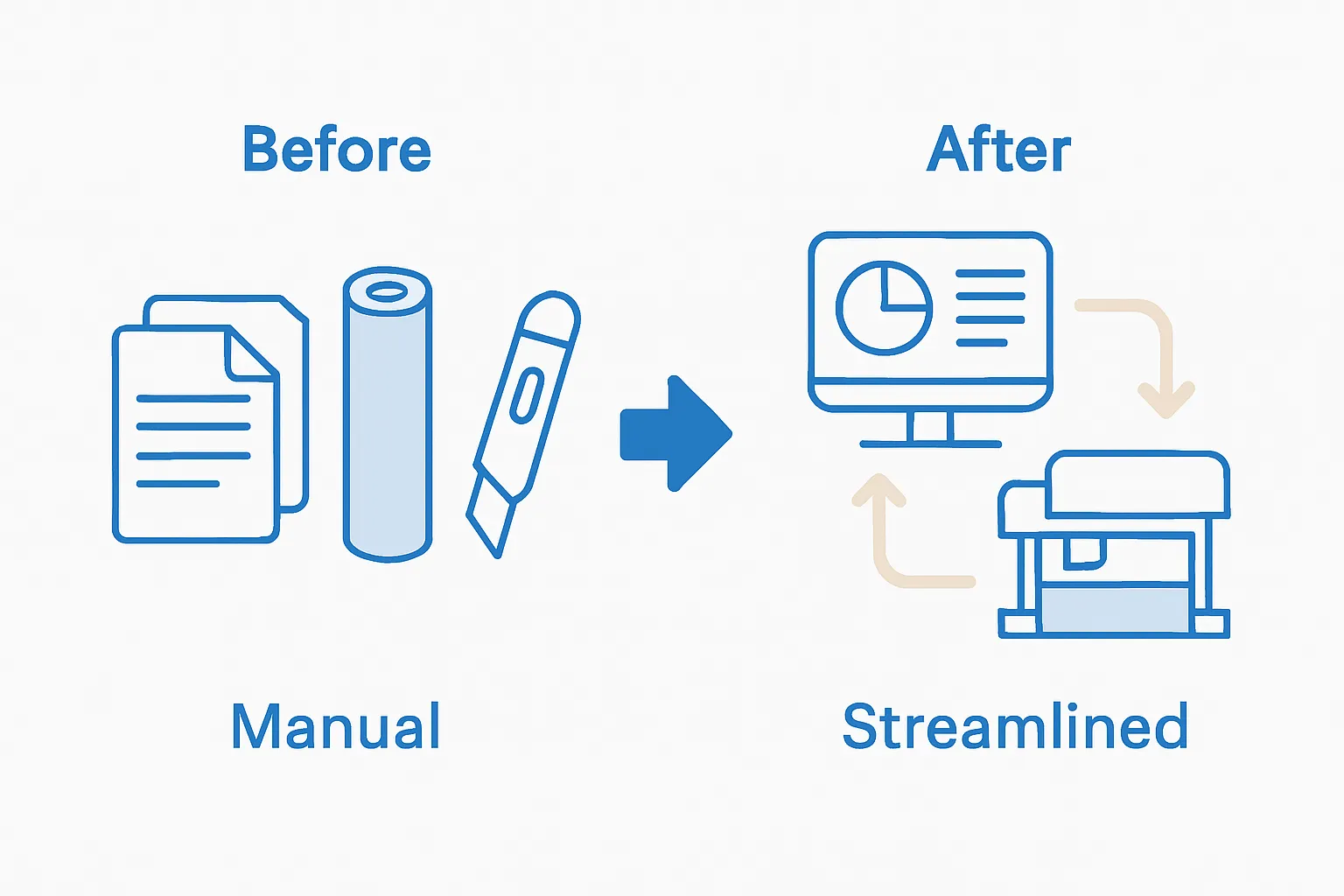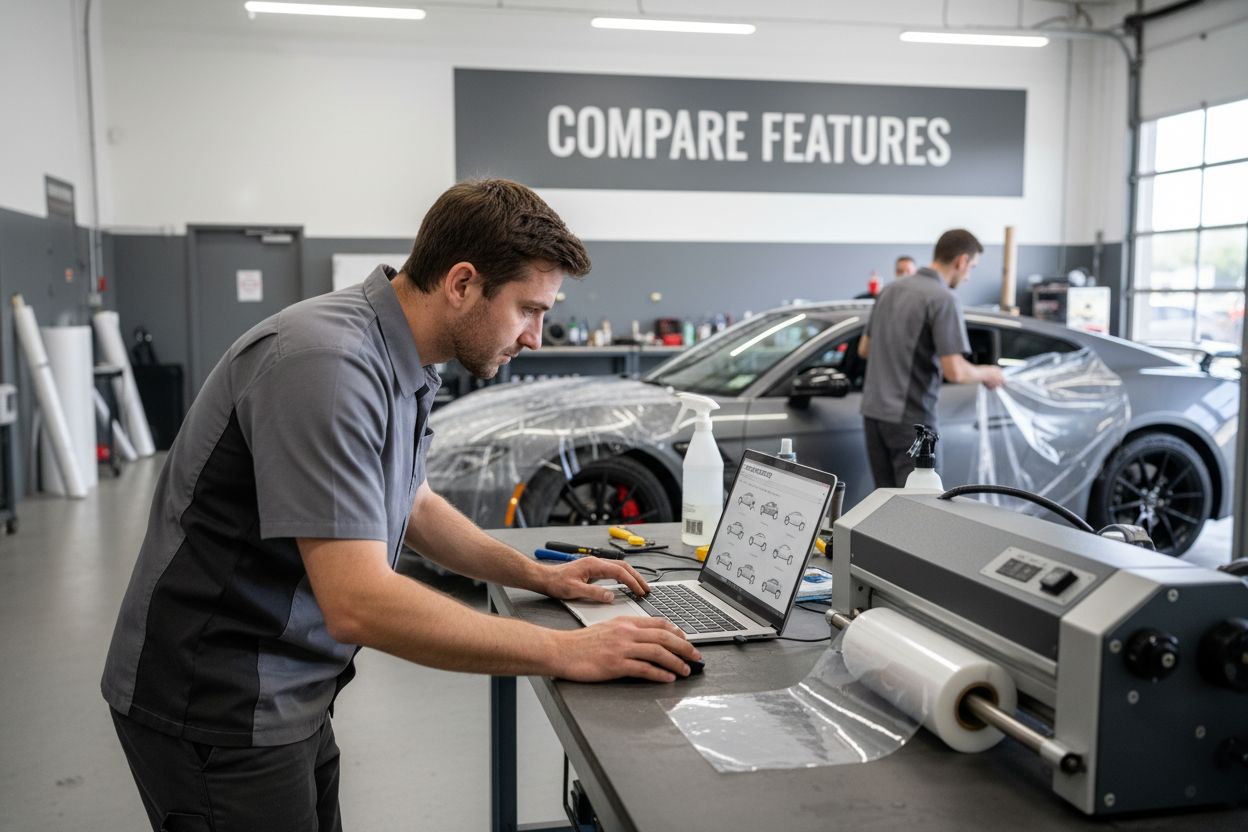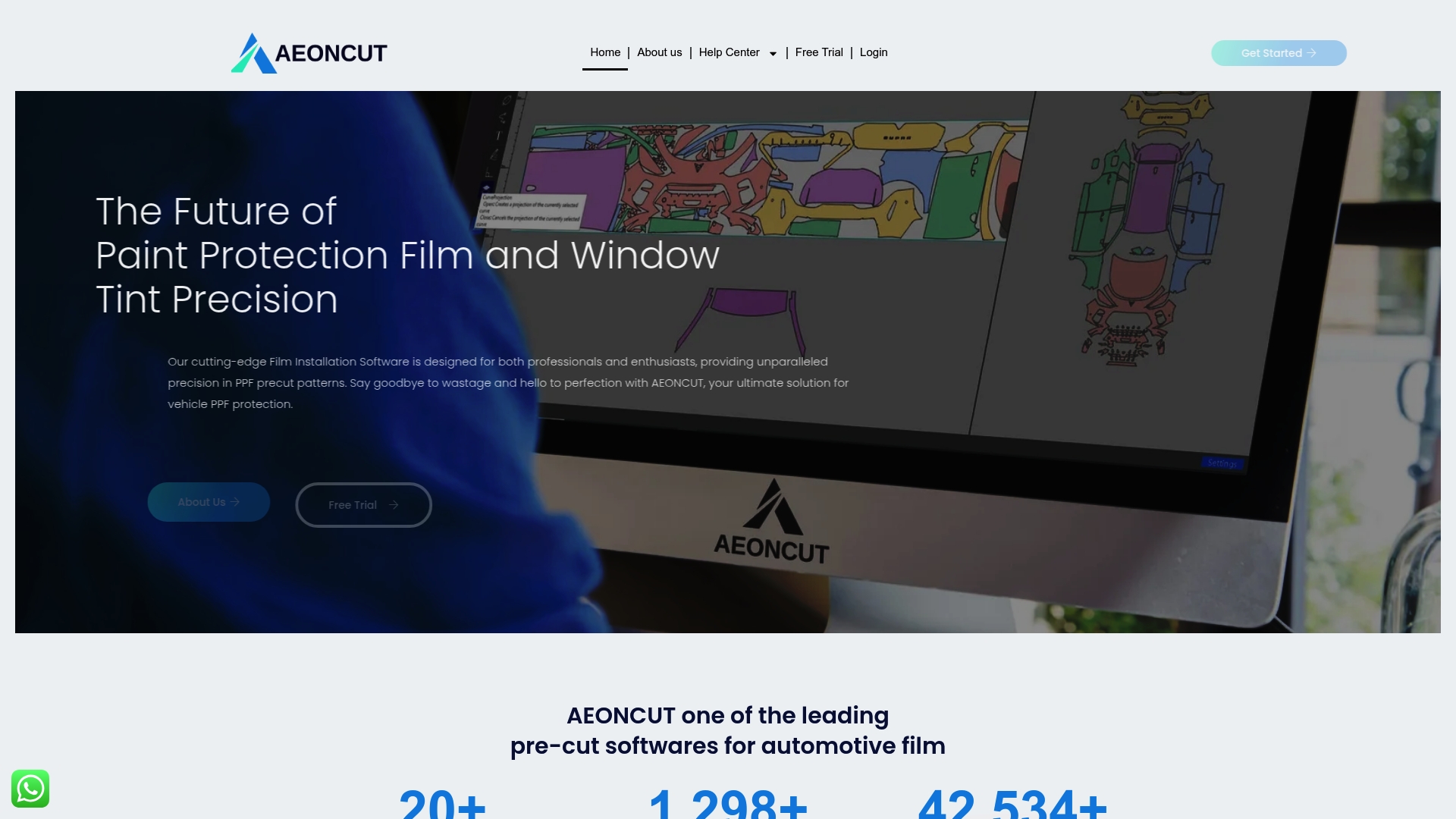
Choosing the right PPF software can completely transform how your dealership or distribution business handles vehicle protection film. Plenty of owners assume it is just about automating cut patterns and nothing more. Yet research reveals that businesses who map their requirements in detail before making a purchase are 65 percent more likely to enjoy a successful software rollout. Most ignore this step and end up wasting both time and money by picking the wrong system.
Table of Contents
- Step 1: Assess Your Business Needs And Requirements
- Step 2: Research Available PPF Software Options
- Step 3: Compare Features And Pricing Structures
- Step 4: Request Demos And Conduct Trials
- Step 5: Make Your Final Selection And Implement
- Step 6: Monitor Performance And Gather Feedback
Quick Summary
| Key Point | Explanation |
|---|---|
| 1. Assess your specific software needs | Conduct a thorough internal review to identify essential capabilities that improve operations and efficiency. |
| 2. Research and compare available options | Explore industry platforms and create a detailed comparison matrix to evaluate features, pricing, and support. |
| 3. Conduct software trials and gather feedback | Schedule demonstrations and real-world trials to assess functionality and gather insights from team members. |
| 4. Implement with a structured plan | Develop a phased implementation strategy that includes training, timeline, and clear success metrics. |
| 5. Monitor performance and adapt continuously | Establish a performance tracking system to evaluate efficiency and user experience, making adjustments as needed. |
Step 1: Assess Your Business Needs and Requirements
Before selecting the best PPF software for your dealership or distribution business, a comprehensive assessment of your specific requirements is crucial. This initial step helps you identify the precise capabilities and features that will streamline your operations and enhance overall efficiency.
Begin by conducting a thorough internal review of your current workflow and technological infrastructure. Examine how your team currently manages vehicle protection film cutting, design processing, and inventory management. Key aspects to evaluate include the volume of vehicles processed monthly, complexity of vehicle models in your portfolio, and existing software or technological systems already in place.
Understanding your unique operational landscape allows you to pinpoint software requirements that directly address your business challenges. Consider factors such as pattern library comprehensiveness, integration capabilities with existing systems, cloud synchronisation features, and scalability potential. Research from Business Technology Insights suggests that businesses who meticulously map their requirements before software selection are 65% more likely to achieve successful implementation.
Engaging your team during this assessment phase is critical. Schedule collaborative sessions with installers, management, and administrative staff to gather comprehensive insights. Each department will offer unique perspectives on software needs. Installers might prioritise precise cutting patterns, while management could focus on reporting and cost tracking capabilities.
Document your findings systematically, creating a detailed requirements matrix that outlines:
- Minimum technical specifications needed
- Budget constraints
- Expected performance metrics
- Integration requirements with existing tools
- Training and support expectations
This methodical approach transforms your software selection from a generic purchase into a strategic business decision tailored precisely to your operational ecosystem.
The table below summarises each stage of the PPF software selection journey, providing a step-by-step overview with outcomes and staff involvement highlighted for clarity.
| Step | Key Outcome | Typical Team Involvement |
|---|---|---|
| Assess Business Needs | Clear definition of required features | Installers, management, admin staff |
| Research Software Options | Shortlist of potential solutions | IT lead, management |
| Compare Features & Pricing | Detailed comparison matrix | Management, finance team |
| Request Demos & Trials | First-hand evaluation and feedback | Installers, admin, management |
| Final Selection & Implementation | Structured rollout and team training | All departments |
| Monitor Performance & Feedback | Ongoing optimisation | All users, management |
 By investing time in understanding your specific needs, you position your business to select a PPF software solution that genuinely enhances productivity and drives long term efficiency.
By investing time in understanding your specific needs, you position your business to select a PPF software solution that genuinely enhances productivity and drives long term efficiency.
Step 2: Research Available PPF Software Options
After thoroughly assessing your business needs, the next critical phase involves comprehensive research into PPF software solutions. This investigative process requires a strategic approach to evaluate the diverse range of options available in the market.
Begin your research by exploring reputable industry platforms, professional forums, and technology review websites that specialize in automotive customization software. Pay close attention to solutions designed specifically for paint protection film and window tinting businesses. Software Evaluation Experts recommend creating a detailed comparison matrix that tracks features, pricing, customer support, and integration capabilities.
Consult professional networks and industry associations to gather insights from peers who have already implemented PPF software. Attend automotive technology conferences, participate in online forums, and engage with professional groups on platforms like LinkedIn. These interactions provide real world perspectives that go beyond marketing materials. Read our guide on PPF cutting software for additional detailed insights into selecting the right solution.
When evaluating potential software options, develop a systematic approach to comparing their capabilities. Look beyond surface level features and examine deeper aspects such as:
- Precision of pattern libraries
- Compatibility with different vehicle models
- Cloud synchronisation capabilities
- User interface intuitiveness
- Frequency of software updates
Demonstrate your due diligence by requesting product demonstrations, free trials, and comprehensive documentation from potential software providers. Schedule direct conversations with sales representatives to understand the nuanced capabilities of each solution. During these interactions, ask targeted questions about scalability, customization options, and long term support strategies.
Verify your research by cross referencing multiple sources and gathering comprehensive feedback. A successful research phase will provide you with a shortlist of software solutions that align precisely with the operational requirements you identified in the previous assessment step.
The table below offers a concise comparison of critical PPF software features discussed in the research section, aiding your structured evaluation of potential platforms.
| Feature | Description | Importance Level |
|---|---|---|
| Pattern Library | Range and accuracy of pre-set cutting templates | High |
| Integration Capabilities | Compatibility with current systems and tools | High |
| Cloud Synchronisation | Ability to access and sync data remotely | Medium |
| User Interface Intuitiveness | Ease of use for technicians and administrators | High |
| Software Update Frequency | Regularity of new features and improvements | Medium |
| Scalability Potential | Support for business growth and expansion | Medium |
Step 3: Compare Features and Pricing Structures
With your initial research complete, the next pivotal step involves a meticulous comparison of features and pricing structures across potential PPF software solutions. This phase requires a strategic and analytical approach to ensure you select a solution that offers maximum value for your specific business requirements.
Develop a comprehensive comparison matrix that goes beyond surface level features, diving deep into the nuanced capabilities of each software option. Pricing Strategy Research indicates that businesses who conduct thorough comparative analyses are 40% more likely to make cost effective technology investments. Create a detailed spreadsheet that captures every critical aspect of potential software solutions.
Pay particular attention to the pricing models presented by different providers. Some software companies offer tiered subscription plans, while others provide perpetual licensing options. Examine the total cost of ownership, which includes not just the initial purchase price, but also implementation costs, training expenses, potential customization fees, and ongoing support charges. Check out our comprehensive guide on PPF software options for additional insights into navigating pricing structures.
Critical features to evaluate during your comparison should include:
- Pattern library comprehensiveness
- Integration capabilities with existing systems
- Frequency of software updates
- Customer support quality and response times
- Scalability potential
Consider both short term and long term financial implications of your software selection. While a cheaper option might seem attractive initially, it could prove more expensive if it lacks critical features or requires frequent manual interventions. Request detailed pricing breakdowns from each vendor, including potential volume discounts, upgrade paths, and additional module costs.

Verify your comparison by creating a weighted scoring system that assigns importance to different features based on your specific business needs. This approach transforms the selection process from a subjective decision to an objective, data driven evaluation. Schedule final demonstrations with your top two or three software providers, allowing your team to experience the solutions firsthand and validate your initial research and comparative analysis.
Step 4: Request Demos and Conduct Trials
With your initial research and comparative analysis complete, the next crucial phase involves requesting demonstrations and conducting hands on trials of potential PPF software solutions. This step transforms theoretical evaluations into practical, real world assessments of software capabilities.
Initiate contact with software providers to schedule comprehensive product demonstrations. These sessions should be more than passive presentations. Technology Evaluation Experts recommend preparing a structured set of specific scenarios and technical challenges that mirror your actual business workflows. This approach allows you to witness the software’s performance in conditions directly relevant to your operational requirements.
Prepare a detailed testing protocol that encompasses multiple critical aspects of your business operations. Learn more about our PPF cutting software evaluation process to understand the nuanced approach to software trials. Request extended trial periods that enable your team to thoroughly explore the software’s capabilities across different vehicle models and cutting scenarios.
During the demonstration and trial phases, focus on gathering comprehensive insights by:
- Evaluating user interface intuitiveness
- Testing pattern precision and accuracy
- Assessing integration capabilities
- Measuring performance under real world conditions
- Checking responsiveness of customer support
Encourage multiple team members from different departments to participate in the trials. Installers, management, and administrative staff will each provide unique perspectives on the software’s functionality. Document their feedback systematically, creating a structured evaluation framework that captures both technical performance and user experience.
Be prepared to negotiate trial terms with software providers. Some may offer limited functionality demos, while others provide full feature access. Communicate your specific testing requirements clearly, ensuring you can comprehensively assess the software’s capabilities. Create a scoring system that allows objective comparison between different solutions, taking into account factors like ease of use, technical performance, and potential impact on your existing workflows.
Step 5: Make Your Final Selection and Implement
After comprehensive research, comparison, and trials, you are now positioned to make a strategic final selection and initiate the implementation of your chosen PPF software solution. This critical phase requires careful planning, stakeholder engagement, and a structured approach to ensure smooth integration into your existing business ecosystem.
Consolidate your evaluation findings by reviewing the comprehensive data collected during your software assessment process. Organizational Change Management Research indicates that detailed documentation and transparent decision making significantly improve technology adoption rates. Prepare a formal recommendation document that outlines the rationale behind your software selection, highlighting key strengths that align with your business requirements.
Explore our comprehensive implementation guide to understand the nuanced approach to software integration. Develop a phased implementation strategy that minimizes operational disruption. This approach typically involves initial pilot testing, gradual team training, and systematic rollout across different departments.
Key considerations during the implementation phase include:
- Establishing a dedicated implementation team
- Creating a realistic timeline with clear milestones
- Developing comprehensive training materials
- Planning for potential technical challenges
- Defining success metrics and performance indicators
Proactively manage the human element of technological change. Engage your team early in the implementation process, addressing potential concerns and creating opportunities for feedback. Schedule multiple training sessions that cater to different learning styles, ensuring every team member feels supported and confident in using the new software.
Verify the implementation’s success by conducting thorough performance assessments. Monitor key performance indicators such as cutting precision, time efficiency, material waste reduction, and overall team productivity. Be prepared to make incremental adjustments and provide ongoing support during the initial months of software adoption. A successful implementation transforms your technological investment from a mere tool to a strategic asset driving your business’s operational excellence.
Step 6: Monitor Performance and Gather Feedback
After implementing your selected PPF software, the critical phase of continuous performance monitoring and feedback collection begins. This ongoing process ensures that your technological investment continues to deliver optimal value and meets the evolving needs of your dealership or distribution business.
Establish a systematic approach to performance tracking that goes beyond surface level metrics. Performance Management Research emphasizes the importance of comprehensive evaluation frameworks. Create a detailed dashboard that captures both quantitative and qualitative data points, including cutting precision, time efficiency, material waste reduction, and user satisfaction levels.
Learn more about our advanced performance tracking methods to understand the nuanced approach to software performance assessment. Implement regular check in meetings with your team to discuss the software’s practical application, encouraging open and constructive dialogue about its strengths and potential improvement areas.
Key performance indicators to monitor include:
- Pattern cutting accuracy
- Time saved per vehicle
- Material waste percentage
- User adoption rate
- Customer satisfaction metrics
Design a structured feedback mechanism that makes it easy and comfortable for team members to share their experiences. Consider implementing anonymous survey tools, regular team meetings, and one on one discussions. Pay special attention to the perspectives of installers who interact with the software most directly, as their insights can reveal practical challenges or unexpected benefits.
Remain flexible and proactive in your approach to software optimization. Be prepared to work closely with the software provider to address any identified issues or explore potential customizations. Regularly review your performance data and feedback to determine whether the software continues to align with your business goals. This iterative approach transforms your PPF software from a static tool into a dynamic, evolving solution that grows alongside your business.
Unlock Effortless PPF Success with AEONCUT’s Advanced Software
Frustrated by complex vehicle models, inconsistent cutting results or wasted material in your dealership or distribution workflow? The article highlights how pinpointing your unique requirements and comparing features is essential for choosing the right PPF solution. At AEONCUT, our PPF software directly addresses these obstacles through an extensive pattern library, seamless integration and precise pattern cutting for every project—no matter how demanding.

Why keep struggling with outdated systems or unreliable results? Join a rapidly growing network of car care professionals who chose AEONCUT for its accuracy, AI-powered auto-nesting and flexible subscription plans. Visit https://aeoncutsw.com today or explore our PPF precut pattern resources for an immediate boost in efficiency. Secure your competitive edge now—bring lasting precision and consistency to your PPF operations.
Frequently Asked Questions
What factors should I consider when selecting PPF software for my dealership?
You should assess your business needs, such as the volume of vehicles processed, existing technological infrastructure, and specific features required, such as pattern library comprehensiveness and integration capabilities.
How can I effectively compare different PPF software options?
Create a detailed comparison matrix that evaluates features, pricing, customer support, and integration capabilities. Consider conducting hands-on trials and requesting product demonstrations to assess usability.
What should I focus on during software trials and demonstrations?
Evaluate the user interface intuitiveness, pattern precision, integration capabilities, and customer support responsiveness. Gathering feedback from various team members is crucial to ensure all perspectives are considered.
How can I monitor the performance of my PPF software after implementation?
Establish a systematic approach to performance tracking through key performance indicators such as cutting precision, time efficiency, and user satisfaction. Regular check-ins and feedback mechanisms among your team can help identify areas for improvement.
Recommended
- Best PPF Software 2025: Top Picks for Auto detailing businesses – AEONCUT PPF Pre-cut Cutting software
- PPF Cutting Software: Essential Guide for Installers 2025 – AEONCUT PPF Pre-cut Cutting software
- Top 5 PPF and Tint Cutting Software for Professionals 2025 – AEONCUT PPF Pre-cut Cutting software
- Top PPF Brands in 2025: A Professional’s Buying Guide – AEONCUT PPF Pre-cut Cutting software
- Maximize Efficiency with Custom Adobe Plugins
- Ignite Your Imagination with Variable Data Printing


